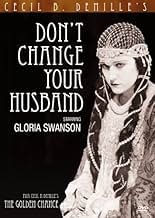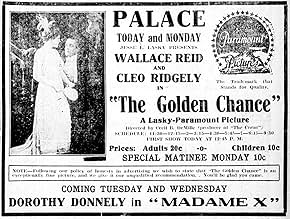Adicionar um enredo no seu idiomaMary Denby becomes a seamstress after her husband Steve wastes their money on booze. Her employer provides her as an escort to accompany millionaire Roger Manning. Her husband tries blackmai... Ler tudoMary Denby becomes a seamstress after her husband Steve wastes their money on booze. Her employer provides her as an escort to accompany millionaire Roger Manning. Her husband tries blackmailing Manning and is later killed by the police, leaving Mary free to wed the millionaire.Mary Denby becomes a seamstress after her husband Steve wastes their money on booze. Her employer provides her as an escort to accompany millionaire Roger Manning. Her husband tries blackmailing Manning and is later killed by the police, leaving Mary free to wed the millionaire.
- Direção
- Roteiristas
- Artistas
- The Rent Collector
- (as Billy Elmer)
- Direção
- Roteiristas
- Elenco e equipe completos
- Produção, bilheteria e muito mais no IMDbPro
Avaliações em destaque
** 1/2 (out of 4)
Early DeMille melodrama centers on an abused wife (Cleo Ridgely) who takes a job working for a rich couple so that she can make money for her drunk husband (Horace B. Carpenter). The rich couple eventually ask her to join a party where she meets a nice millionaire (Wallace Reid) and the two quickly fall in love, although he doesn't know she's married. This is yet another silent film from DeMille, which has pretty much been forgotten but once again that's a shame because this has quite a few good things to offer. I think the film's biggest weakness is its slow pacing, which hampers the film some, especially in the middle. The movie runs a short 73-minutes so the pacing isn't a huge problem but it doesn't help either. What really stands out were the performances with Ridgely doing a great job as the abused wife who gets her Cinderella chance but doesn't know if she should take it or not. She handles the role with a lot of flare and really makes her character quite memorable. Carpenter is also very good as the snake husband as is Raymond Hatton, a DeMille regular, who plays the sidekick. The real standout here, and the one I was most interested in seeing, was Reid. For those who don't know, Reid was involved in a train wreck in 1919 and being a big money maker, the studio forced a doctor to get him high on morphine so that he could continue to work. Reid eventually lost his mind and ended up dying in a mental hospital a couple years later. This was my first chance seeing him in a leading role, although he did have a brief scene in The Birth of a Nation. I was very impressed with both his acting and physical presence here as he manages to fit the romantic lead very well but he also delivers something a bit deeper. He does a lot of acting with his face, which really makes him stand out and deliver. The film ends in a rather bizarre way but I respect what DeMille did at the very end, although I won't ruin it here. There's also a big fight sequence at the end, which looks very realistic and manges to be quite exciting. While the film isn't a complete success it's still worthy of a viewing.
Now neither is, I think, especially wonderful. The weaknesses of the melodramatic plot are the same in both cases. This film also suffers, as do many US films of around 1914-1915 from an overuse of close-up and lose medium shots (the recrudescence of the "facial"). The Cheat of the same year is, I think, a much better film. But it does have its good points and other reviewers have described these very well and it is, to my mind, a better film than the much gaudier and less believable Forbidden Fruit.
So why did DeMille's films decline in quality while he steadily became more famous and more acclaimed. It is not an absolutely straight line (there are some other good films throughout the silent period) but by and large DeMille films get worse as they go along and the reason I think is very clear to see. Throughout his career two elements characterise DeMille films - a great natural talent and a great and seemingly an equally naturally vulgarity and taste for whimsy, along with an understandable desire to please (very much indeed to develop a kind of "cinema of attractions" that is so falsely supposed to characterise earlier films. And as his career progressed, it was this natural vulgarity that increasingly got the upper hand. It made him in the end a popular film-maker (popular too with the studios) but not a good one and certainly not as good a one as, given the natural talent, he might have been.
In Forbidden Fruit for instance he inserts a "Cinderella fantasy" scene (a gimmick he had started to use in Male and Female and which became a sort of trademark). Yes, it is in a way effective as spectacle but it totally undermines any seriousness the film might otherwise have had. In the same way all the gritty elements of the film (particularly the marital violence) is all softened in the later film.
I was always curious about Wallace Reid, because I read a little about his tragic personal life in a movie book years ago--here he appears in all his youthful strength and good looks. Cleo Ridgely projects a lot of emotion, and only occasionally goes a little overboard. It's easy to sympathize with the plight of her character. The two bad guys are straight out of Jacob Riis photos. I can see why they didn't work for some viewers who have posted their comments, but I found them fascinating, especially the way their dark emotions were enhanced by the movie's lighting. My favorite player was Edythe Chapman, as a wealthy woman hoping to advance her husband's business.
If you can get into the spirit of 1915 in order to enjoy this film on its own level, you will find it worth your while.
How wonderful is seeing Wallace Reid in his youthful prime four years before the 1919 accident that started him on his morphine decline? Serendipity provided us with a nearly pristine print for study, and the intimate yet predictable story provides many nuances worth savoring, not the least of which are intelligent, subtle characterizations by every player. Jeanie Macpherson's scenario weaves an interesting tapestry out of died-in-the-wool fabrics.
Reid shines with an admirably constrained performance, but the one oddity is his co-star, buxom and pretty Cleo Ridgely, who I swear looks a bit cross-eyed and tends to mainly express hand-wringing angst to an annoying degree. Sharp performances by the five other secondary players provide enough support to divert the viewer from her limitations, and the overall hour, augmented by some sharp, revealing extreme close-ups, puts genuine oomph into the outing. I wouldn't mind seeing it a second time someday, which, in my opinion, is one mark of a good movie.
Você sabia?
- CuriosidadesThe role of "Mary Denby" was first assigned to Edna Goodrich, and a good portion of the film was in the can when her drinking problem became so severe that Cecil B. DeMille fired her and shut down production long enough to find a new star, Cleo Ridgely. DeMille was then forced to continue directing Enganar e Perdoar (1915) during the day while directing the re-shoots of this movie at night.
- ConexõesFeatured in Cecil B. DeMille: American Epic (2004)
Principais escolhas
Detalhes
Bilheteria
- Orçamento
- US$ 18.711 (estimativa)
- Tempo de duração1 hora 14 minutos
- Mixagem de som
- Proporção
- 1.33 : 1
Contribua para esta página

























